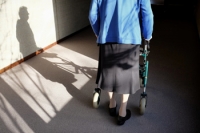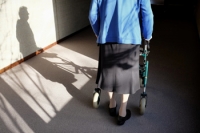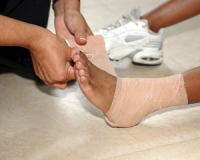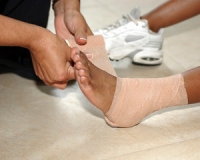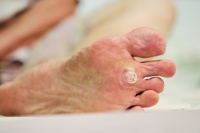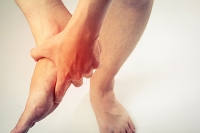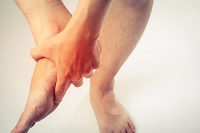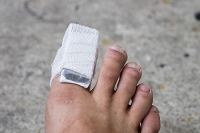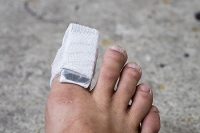
Blog (826)
Taking Care of Your Feet
 Feet go through a lot of wear and tear over the course of one’s life, so it's important to take small steps to ensure their overall health. Wearing comfortable shoes is key when trying to keep your feet healthy. Shoes that are tight or lack support can lead to various types of uncomfortable foot conditions. Some of these conditions include bunions, Morton’s neuroma, ingrown toenails, and blisters. Daily walking routines help keep the muscles in your feet active, flexible, and strong, which could prevent fallen arches or other complications later on in life. Most of the time, feet spend majority of the day confined to a shoe, which can trap moisture and bacteria. Cleaning your feet daily and wearing socks helps to prevent bacterial and fungal infections. Moisturizing your feet also contributes to their health by preventing dry, cracked, or scaly skin. If you would like any additional information on how to care for your feet, then it is suggested you speak with a podiatrist.
Feet go through a lot of wear and tear over the course of one’s life, so it's important to take small steps to ensure their overall health. Wearing comfortable shoes is key when trying to keep your feet healthy. Shoes that are tight or lack support can lead to various types of uncomfortable foot conditions. Some of these conditions include bunions, Morton’s neuroma, ingrown toenails, and blisters. Daily walking routines help keep the muscles in your feet active, flexible, and strong, which could prevent fallen arches or other complications later on in life. Most of the time, feet spend majority of the day confined to a shoe, which can trap moisture and bacteria. Cleaning your feet daily and wearing socks helps to prevent bacterial and fungal infections. Moisturizing your feet also contributes to their health by preventing dry, cracked, or scaly skin. If you would like any additional information on how to care for your feet, then it is suggested you speak with a podiatrist.
Everyday foot care is very important to prevent infection and other foot ailments. If you need your feet checked, contact Dr. Kenneth Donovan from Advanced Care Foot and Ankle. Our doctor can provide the care you need to keep you pain-free and on your feet.
Everyday Foot Care
Often, people take care of their bodies, face and hair more so than they do for their feet. But the feet are a very important aspect of our bodies, and one that we should pay more attention to. Without our feet, we would not be able to perform most daily tasks.
It is best to check your feet regularly to make sure there are no new bruises or cuts that you may not have noticed before. For dry feet, moisturizer can easily be a remedy and can be applied as often as necessary to the affected areas. Wearing shoes that fit well can also help you maintain good foot health, as well as making it easier to walk and do daily activities without the stress or pain of ill-fitting shoes, high heels, or even flip flops. Wearing clean socks with closed shoes is important to ensure that sweat and bacteria do not accumulate within the shoe. Clean socks help to prevent Athlete’s foot, fungi problems, bad odors, and can absorb sweat.
If you have any questions please feel free to contact one of our offices located in Warren, Livingston, and Toms River, NJ . We offer the newest diagnostic and treatment technologies for all your foot and ankle needs.
Read more about Every Day Foot CareMethods That May Help to Prevent Falling
Research has shown that falling is common among people who are sixty-five years and older. Severe falls can result in broken bones or head injuries, and a fear of falling may deter the individual from staying active. Many older people have diminished coordination and flexibility, and this may make it easier to fall. Additionally, dizziness may be caused by certain medications, and objects may be harder to see as a result of fading eyesight. It may be beneficial to make some changes to the living environment. These may include securing railings on the steps, and increasing the amount of lighting throughout the house. Many patients find it safer to have grab bars installed in the bathroom and shower area, or it may be helpful to use a shower chair. Using a walker or cane may also be beneficial in preventing falls. If you would like additional information about falls prevention, then it is recommended you speak to a podiatrist to learn about more helpful methods.
Preventing falls among the elderly is very important. If you are older and have fallen or fear that you are prone to falling, consult with Dr. Kenneth Donovan from Advanced Care Foot and Ankle. Our doctor will assess your condition and provide you with quality advice and care.
Every 11 seconds, an elderly American is being treated in an emergency room for a fall related injury. Falls are the leading cause of head and hip injuries for those 65 and older. Due to decreases in strength, balance, senses, and lack of awareness, elderly persons are very susceptible to falling. Thankfully, there are a number of things older persons can do to prevent falls.
How to Prevent Falls
Some effective methods that older persons can do to prevent falls include:
- Enrolling in strength and balance exercise program to increase balance and strength
- Periodically having your sight and hearing checked
- Discuss any medications you have with a doctor to see if it increases the risk of falling
- Clearing the house of falling hazards and installing devices like grab bars and railings
- Utilizing a walker or cane
- Wearing shoes that provide good support and cushioning
- Talking to family members about falling and increasing awareness
Falling can be a traumatic and embarrassing experience for elderly persons; this can make them less willing to leave the house, and less willing to talk to someone about their fears of falling. Doing such things, however, will increase the likelihood of tripping or losing one’s balance. Knowing the causes of falling and how to prevent them is the best way to mitigate the risk of serious injury.
If you have any questions, please feel free to contact one of our offices located in Warren, Livingston, and Toms River, NJ. We offer the newest diagnostic and treatment technologies for all your foot care needs.
Methods That May Help to Prevent Falling
 Research has shown that falling is common among people who are sixty-five years and older. Severe falls can result in broken bones or head injuries, and a fear of falling may deter the individual from staying active. Many older people have diminished coordination and flexibility, and this may make it easier to fall. Additionally, dizziness may be caused by certain medications, and objects may be harder to see as a result of fading eyesight. It may be beneficial to make some changes to the living environment. These may include securing railings on the steps, and increasing the amount of lighting throughout the house. Many patients find it safer to have grab bars installed in the bathroom and shower area, or it may be helpful to use a shower chair. Using a walker or cane may also be beneficial in preventing falls. If you would like additional information about falls prevention, then it is recommended you speak to a podiatrist to learn about more helpful methods.
Research has shown that falling is common among people who are sixty-five years and older. Severe falls can result in broken bones or head injuries, and a fear of falling may deter the individual from staying active. Many older people have diminished coordination and flexibility, and this may make it easier to fall. Additionally, dizziness may be caused by certain medications, and objects may be harder to see as a result of fading eyesight. It may be beneficial to make some changes to the living environment. These may include securing railings on the steps, and increasing the amount of lighting throughout the house. Many patients find it safer to have grab bars installed in the bathroom and shower area, or it may be helpful to use a shower chair. Using a walker or cane may also be beneficial in preventing falls. If you would like additional information about falls prevention, then it is recommended you speak to a podiatrist to learn about more helpful methods.
Preventing falls among the elderly is very important. If you are older and have fallen or fear that you are prone to falling, consult with Dr. Kenneth Donovan from Advanced Care Foot and Ankle. Our doctor will assess your condition and provide you with quality advice and care.
Every 11 seconds, an elderly American is being treated in an emergency room for a fall related injury. Falls are the leading cause of head and hip injuries for those 65 and older. Due to decreases in strength, balance, senses, and lack of awareness, elderly persons are very susceptible to falling. Thankfully, there are a number of things older persons can do to prevent falls.
How to Prevent Falls
Some effective methods that older persons can do to prevent falls include:
- Enrolling in strength and balance exercise program to increase balance and strength
- Periodically having your sight and hearing checked
- Discuss any medications you have with a doctor to see if it increases the risk of falling
- Clearing the house of falling hazards and installing devices like grab bars and railings
- Utilizing a walker or cane
- Wearing shoes that provide good support and cushioning
- Talking to family members about falling and increasing awareness
Falling can be a traumatic and embarrassing experience for elderly persons; this can make them less willing to leave the house, and less willing to talk to someone about their fears of falling. Doing such things, however, will increase the likelihood of tripping or losing one’s balance. Knowing the causes of falling and how to prevent them is the best way to mitigate the risk of serious injury.
If you have any questions, please feel free to contact one of our offices located in Warren, Livingston, and Toms River, NJ . We offer the newest diagnostic and treatment technologies for all your foot care needs.
Ankle Sprains May Take Time to Heal
Research has shown that several athletes endure injuries to the ankles, and many of these are ankle sprains. It may also be common among the general population, and many people will experience this type of injury at some point in their lives. It generally occurs when the ankle rolls inward, and severe pain and discomfort may often accompany ankle sprains. It may happen as a result of suddenly stepping off a curb or falling from an extended height. This type of injury requires patience and time to heal properly, and walking on it must be executed gently. Once the ankle sprain has occurred, it’s important to rest the foot, which allows pressure to be taken off the ankle. Applying ice to the affected area may be helpful in alleviating a portion of the swelling that may be present, in addition to wrapping the foot in a bandage, which may be useful in applying pressure. If you have sprained your ankle, it is suggested to speak with a podiatrist as quickly as possible, so the correct treatment can begin.
Ankle sprains are common but need immediate attention. If you need your feet checked, contact Dr. Kenneth Donovan from Advanced Care Foot and Ankle. Our doctor can provide the care you need to keep you pain-free and on your feet.
How Does an Ankle Sprain Occur?
Ankle sprains take place when the ligaments in your ankle are torn or stretched beyond their limits. There are multiple ways that the ankle can become injured, including twisting or rolling over onto your ankle, putting undue stress on it, or causing trauma to the ankle itself.
What Are the Symptoms?
- Mild to moderate bruising
- Limited mobility
- Swelling
- Discoloration of the skin (depending on severity)
Preventing a Sprain
- Wearing appropriate shoes for the occasion
- Stretching before exercises and sports
- Knowing your limits
Treatment of a Sprain
Treatment of a sprain depends on the severity.
Many times, people are told to rest and remain off their feet completely, while others are given an air cast. If the sprain is very severe, surgery may be required.
If you have suffered an ankle sprain previously, you may want to consider additional support such as a brace and regular exercises to strengthen the ankle.
If you have any questions please feel free to contact one of our offices located in Warren, Livingston, and Toms River, NJ . We offer the newest diagnostic and treatment technologies for all your foot and ankle needs.
Ankle Sprains May Take Time to Heal
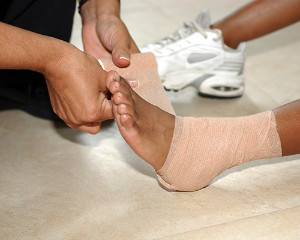 Research has shown that several athletes endure injuries to the ankles, and many of these are ankle sprains. It may also be common among the general population, and many people will experience this type of injury at some point in their lives. It generally occurs when the ankle rolls inward, and severe pain and discomfort may often accompany ankle sprains. It may happen as a result of suddenly stepping off a curb or falling from an extended height. This type of injury requires patience and time to heal properly, and walking on it must be executed gently. Once the ankle sprain has occurred, it’s important to rest the foot, which allows pressure to be taken off the ankle. Applying ice to the affected area may be helpful in alleviating a portion of the swelling that may be present, in addition to wrapping the foot in a bandage, which may be useful in applying pressure. If you have sprained your ankle, it is suggested to speak with a podiatrist as quickly as possible, so the correct treatment can begin.
Research has shown that several athletes endure injuries to the ankles, and many of these are ankle sprains. It may also be common among the general population, and many people will experience this type of injury at some point in their lives. It generally occurs when the ankle rolls inward, and severe pain and discomfort may often accompany ankle sprains. It may happen as a result of suddenly stepping off a curb or falling from an extended height. This type of injury requires patience and time to heal properly, and walking on it must be executed gently. Once the ankle sprain has occurred, it’s important to rest the foot, which allows pressure to be taken off the ankle. Applying ice to the affected area may be helpful in alleviating a portion of the swelling that may be present, in addition to wrapping the foot in a bandage, which may be useful in applying pressure. If you have sprained your ankle, it is suggested to speak with a podiatrist as quickly as possible, so the correct treatment can begin.
Ankle sprains are common but need immediate attention. If you need your feet checked, contact Dr. Kenneth Donovan from Advanced Care Foot and Ankle. Our doctor can provide the care you need to keep you pain-free and on your feet.
How Does an Ankle Sprain Occur?
Ankle sprains take place when the ligaments in your ankle are torn or stretched beyond their limits. There are multiple ways that the ankle can become injured, including twisting or rolling over onto your ankle, putting undue stress on it, or causing trauma to the ankle itself.
What Are the Symptoms?
- Mild to moderate bruising
- Limited mobility
- Swelling
- Discoloration of the skin (depending on severity)
Preventing a Sprain
- Wearing appropriate shoes for the occasion
- Stretching before exercises and sports
- Knowing your limits
Treatment of a Sprain
Treatment of a sprain depends on the severity. Many times, people are told to rest and remain off their feet completely, while others are given an air cast. If the sprain is very severe, surgery may be required.
If you have suffered an ankle sprain previously, you may want to consider additional support such as a brace and regular exercises to strengthen the ankle.
If you have any questions please feel free to contact one of our offices located in Warren, Livingston, and Toms River, NJ . We offer the newest diagnostic and treatment technologies for all your foot and ankle needs.
How to Prevent Plantar Warts from Recurring
Plantar warts are common warts that appear on the bottom of the feet. They are caused by human papillomavirus (HPV) and attack tiny cuts, breaks, or weak spots on the sole of the foot. They are relatively easy to treat, but some people have trouble keeping them away once they have gotten them. There could be some lingering bacteria in shoes, slippers or any footwear that was worn while the plantar warts were present, so it is important to wear socks after being treated. Locker rooms and the areas surrounding swimming pools are high risk environments for contracting plantar warts, therefore it is best to avoid being barefoot in these areas. Certain oils can also help treat and prevent plantar warts. Some of these oils include, tincture of iodine, tea tree oil, and turmeric in olive oil. If you have plantar warts or are concerned about contracting them again, then it is recommended you consult with a podiatrist for more information.
Plantar warts can be very uncomfortable. If you need your feet checked, contact Dr. Kenneth Donovan from Advanced Care Foot and Ankle. Our doctor will assist you with all of your foot and ankle needs.
About Plantar Warts
Plantar warts are the result of HPV, or human papillomavirus, getting into open wounds on the feet. They are mostly found on the heels or balls of the feet.
While plantar warts are generally harmless, those experiencing excessive pain or those suffering from diabetes or a compromised immune system require immediate medical care. Plantar warts are easily diagnosed, usually through scraping off a bit of rough skin or by getting a biopsy.
Symptoms
- Lesions on the bottom of your feet, usually rough and grainy
- Hard or thick callused spots
- Wart seeds, which are small clotted blood vessels that look like little black spots
- Pain, discomfort, or tenderness of your feet when walking or standing
Treatment
- Freezing
- Electric tool removal
- Laser Treatment
- Topical Creams (prescription only)
- Over-the-counter medications
To help prevent developing plantar warts, avoid walking barefoot over abrasive surfaces that can cause cuts or wounds for HPV to get into. Avoiding direct contact with other warts, as well as not picking or rubbing existing warts, can help prevent the further spread of plantar warts. However, if you think you have developed plantar warts, speak to your podiatrist. He or she can diagnose the warts on your feet and recommend the appropriate treatment options.
If you have any questions please feel free to contact one of our offices located in Warren, Livingston, and Toms River, NJ . We offer the newest diagnostic and treatment technologies for all your foot and ankle needs.
Treating Cuboid Syndrome
Cuboid syndrome is caused by the cuboid bone shifting out of alignment with surrounding bones, which then may cause pain in the middle of the foot. There are various forms of treatment for cuboid syndrome, including home remedies and help from a medical professional. The first step in treating this condition involves rest, because reducing activity that puts pressure on the injured area might give the bone space to heal. Home remedies involve, resting, icing, compressing and elevating the foot. If the pain perseveres, then it may be time to seek help from a medical professional. Two examples of possible treatments are the cuboid whip and the cuboid squeeze. Both options involve manipulating the cuboid bone back into place. Manipulation should be more successful when it is done within 24 hours after the injury occurs, so seeking professional help is important. Foot manipulation may not be the best option if an individual is dealing with other foot conditions, so if you feel that you may have cuboid syndrome or have similar pain, then it is recommended to speak to a podiatrist to find the right treatment for your specific needs.
Cuboid syndrome, also known as cuboid subluxation, occurs when the joints and ligaments near the cuboid bone in the foot become torn. If you have cuboid syndrome, consult with Dr. Kenneth Donovan from Advanced Care Foot and Ankle. Our doctor will assess your condition and provide you with quality foot and ankle treatment.
Cuboid syndrome is a common cause of lateral foot pain, which is pain on the outside of the foot. The condition may happen suddenly due to an ankle sprain, or it may develop slowly overtime from repetitive tension through the bone and surrounding structures.
Causes
The most common causes of cuboid syndrome include:
- Injury – The most common cause of this ailment is an ankle sprain.
- Repetitive Strain – Tension placed through the peroneus longus muscle from repetitive activities such as jumping and running may cause excessive traction on the bone causing it to sublux.
- Altered Foot Biomechanics – Most people suffering from cuboid subluxation have flat feet.
Symptoms
A common symptom of cuboid syndrome is pain along the outside of the foot which can be felt in the ankle and toes. This pain may create walking difficulties and may cause those with the condition to walk with a limp.
Diagnosis
Diagnosis of cuboid syndrome is often difficult, and it is often misdiagnosed. X-rays, MRIs and CT scans often fail to properly show the cuboid subluxation. Although there isn’t a specific test used to diagnose cuboid syndrome, your podiatrist will usually check if pain is felt while pressing firmly on the cuboid bone of your foot.
Treatment
Just as the range of causes varies widely, so do treatments. Some more common treatments are ice therapy, rest, exercise, taping, and orthotics.
If you have any questions, please feel free to contact one of our offices located in Warren, Livingston, and Toms River, NJ . We offer the newest diagnostic and treatment technologies for all your foot care needs.
Treating Cuboid Syndrome
 Cuboid syndrome is caused by the cuboid bone shifting out of alignment with surrounding bones, which then may cause pain in the middle of the foot. There are various forms of treatment for cuboid syndrome, including home remedies and help from a medical professional. The first step in treating this condition involves rest, because reducing activity that puts pressure on the injured area might give the bone space to heal. Home remedies involve, resting, icing, compressing and elevating the foot. If the pain perseveres, then it may be time to seek help from a medical professional. Two examples of possible treatments are the cuboid whip and the cuboid squeeze. Both options involve manipulating the cuboid bone back into place. Manipulation should be more successful when it is done within 24 hours after the injury occurs, so seeking professional help is important. Foot manipulation may not be the best option if an individual is dealing with other foot conditions, so if you feel that you may have cuboid syndrome or have similar pain, then it is recommended to speak to a podiatrist to find the right treatment for your specific needs.
Cuboid syndrome is caused by the cuboid bone shifting out of alignment with surrounding bones, which then may cause pain in the middle of the foot. There are various forms of treatment for cuboid syndrome, including home remedies and help from a medical professional. The first step in treating this condition involves rest, because reducing activity that puts pressure on the injured area might give the bone space to heal. Home remedies involve, resting, icing, compressing and elevating the foot. If the pain perseveres, then it may be time to seek help from a medical professional. Two examples of possible treatments are the cuboid whip and the cuboid squeeze. Both options involve manipulating the cuboid bone back into place. Manipulation should be more successful when it is done within 24 hours after the injury occurs, so seeking professional help is important. Foot manipulation may not be the best option if an individual is dealing with other foot conditions, so if you feel that you may have cuboid syndrome or have similar pain, then it is recommended to speak to a podiatrist to find the right treatment for your specific needs.
Cuboid syndrome, also known as cuboid subluxation, occurs when the joints and ligaments near the cuboid bone in the foot become torn. If you have cuboid syndrome, consult with Dr. Kenneth Donovan from Advanced Care Foot and Ankle. Our doctor will assess your condition and provide you with quality foot and ankle treatment.
Cuboid syndrome is a common cause of lateral foot pain, which is pain on the outside of the foot. The condition may happen suddenly due to an ankle sprain, or it may develop slowly overtime from repetitive tension through the bone and surrounding structures.
Causes
The most common causes of cuboid syndrome include:
- Injury – The most common cause of this ailment is an ankle sprain.
- Repetitive Strain – Tension placed through the peroneus longus muscle from repetitive activities such as jumping and running may cause excessive traction on the bone causing it to sublux.
- Altered Foot Biomechanics – Most people suffering from cuboid subluxation have flat feet.
Symptoms
A common symptom of cuboid syndrome is pain along the outside of the foot which can be felt in the ankle and toes. This pain may create walking difficulties and may cause those with the condition to walk with a limp.
Diagnosis
Diagnosis of cuboid syndrome is often difficult, and it is often misdiagnosed. X-rays, MRIs and CT scans often fail to properly show the cuboid subluxation. Although there isn’t a specific test used to diagnose cuboid syndrome, your podiatrist will usually check if pain is felt while pressing firmly on the cuboid bone of your foot.
Treatment
Just as the range of causes varies widely, so do treatments. Some more common treatments are ice therapy, rest, exercise, taping, and orthotics.
If you have any questions, please feel free to contact one of our offices located in Warren, Livingston, and Toms River, NJ . We offer the newest diagnostic and treatment technologies for all your foot care needs.
Read more about Cuboid Syndrome
Symptoms of a Broken Toe
The symptoms may be similar in sprained and broken toes, and it may be difficult to determine the extent of the injury. If the bone is intact, it is most likely a sprained toe, and one or more broken bones are indicative of a fractured toe. There are several symptoms that are associated with broken toes, including severe discomfort and pain beginning at the time of the injury, bruising on the toe and surrounding area, in addition to the inability to walk and put weight on it. Two common causes for broken toes to occur may include stubbing it against something hard or dropping a heavy object on it. Once a proper diagnosis is performed, which typically consists of having an X-ray taken, it will be confirmed if the toe is broken. At this time, the correct treatment procedure can begin, which will generally include resting the toe, and splinting it to the toe next to it, which may aid in stabilizing it. If you feel you have broken your toe, it is recommended that you speak to a podiatrist as quickly as possible, so a proper diagnosis can be determined.
Broken toes may cause a lot of pain and should be treated as soon as possible. If you have any concerns about your feet, contact Dr. Kenneth Donovan from Advanced Care Foot and Ankle. Our doctor will treat your foot and ankle needs.
What Is a Broken Toe?
A broken toe occurs when one or more of the toe bones of the foot are broken after an injury. Injuries such as stubbing your toe or dropping a heavy object on it may cause a toe fracture.
Symptoms of a Broken Toe
- Swelling
- Pain (with/without wearing shoes)
- Stiffness
- Nail Injury
Although the injured toe should be monitored daily, it is especially important to have a podiatrist look at your toe if you have severe symptoms. Some of these symptoms include worsening or new pain that is not relieved with medication, sores, redness, or open wounds near the toe.
If you have any questions, please feel free to contact one of our offices located in Warren, Livingston, and Toms River, NJ . We offer the newest diagnostic and treatment technologies for all your foot care needs.
Symptoms of a Broken Toe
 The symptoms may be similar in sprained and broken toes, and it may be difficult to determine the extent of the injury. If the bone is intact, it is most likely a sprained toe, and one or more broken bones are indicative of a fractured toe. There are several symptoms that are associated with broken toes, including severe discomfort and pain beginning at the time of the injury, bruising on the toe and surrounding area, in addition to the inability to walk and put weight on it. Two common causes for broken toes to occur may include stubbing it against something hard or dropping a heavy object on it. Once a proper diagnosis is performed, which typically consists of having an X-ray taken, it will be confirmed if the toe is broken. At this time, the correct treatment procedure can begin, which will generally include resting the toe, and splinting it to the toe next to it, which may aid in stabilizing it. If you feel you have broken your toe, it is recommended that you speak to a podiatrist as quickly as possible, so a proper diagnosis can be determined.
The symptoms may be similar in sprained and broken toes, and it may be difficult to determine the extent of the injury. If the bone is intact, it is most likely a sprained toe, and one or more broken bones are indicative of a fractured toe. There are several symptoms that are associated with broken toes, including severe discomfort and pain beginning at the time of the injury, bruising on the toe and surrounding area, in addition to the inability to walk and put weight on it. Two common causes for broken toes to occur may include stubbing it against something hard or dropping a heavy object on it. Once a proper diagnosis is performed, which typically consists of having an X-ray taken, it will be confirmed if the toe is broken. At this time, the correct treatment procedure can begin, which will generally include resting the toe, and splinting it to the toe next to it, which may aid in stabilizing it. If you feel you have broken your toe, it is recommended that you speak to a podiatrist as quickly as possible, so a proper diagnosis can be determined.
Broken toes may cause a lot of pain and should be treated as soon as possible. If you have any concerns about your feet, contact Dr. Kenneth Donovan from Advanced Care Foot and Ankle. Our doctor will treat your foot and ankle needs.
What Is a Broken Toe?
A broken toe occurs when one or more of the toe bones of the foot are broken after an injury. Injuries such as stubbing your toe or dropping a heavy object on it may cause a toe fracture.
Symptoms of a Broken Toe
- Swelling
- Pain (with/without wearing shoes)
- Stiffness
- Nail Injury
Although the injured toe should be monitored daily, it is especially important to have a podiatrist look at your toe if you have severe symptoms. Some of these symptoms include worsening or new pain that is not relieved with medication, sores, redness, or open wounds near the toe.
If you have any questions, please feel free to contact one of our offices located in Warren, Livingston, and Toms River, NJ . We offer the newest diagnostic and treatment technologies for all your foot care needs.

